
Why Understanding Root Cause Analysis (RCA) Is Critical to any Organization
It doesn’t matter how big your organization is or what area it operates in, there are some core concepts to project management and general leadership that are critical to understand if you want to ensure things are moving in the right direction. When you encounter a problem during the regular course of the organization’s operation, for example, it’s important to know how to get to the true underlying cause of the issue, so you can prevent it from resurfacing in the future.
The basics of root cause analysis
As the name implies, the method seeks to identify the root cause for any issue. Keep in mind that RCA is typically not concerned with developing a proper solution, but rather it will point you in the right direction with regards to what the problem is in the first place.
What’s a root cause, specifically? In technical terms, it’s an aspect of the organization which, when changed, completely resolves the original problem. Knowing how to differentiate the root cause from the various intermediate issues that may arise during its analysis is a skill every leader should possess.
Most often, this involves a process breakdown in the business. We cannot assign the cause to the worker who made the mistake, or the department that hired the employee. We need to determine the lack of on-boarding process for the employee, or the lack of qualification process that needs to be improved.
Dr. Edwards Deming said that 94% of all business problems are management’s fault, since they control the processes. Before we look at individuals as the root cause, we must first review all processes and make sure they are not to blame. In almost all cases, we will find an undefined or lacking process that has many opportunities for improvement!
What if there is no root cause?
When we are investing a problem, it is often assumed that every problem is a result of something going wrong. A step was skipped, a part was put in backwards, a typo was made, a field was left blank, or an item was shipped to the wrong person.
However, not all process failures are due to mistakes or errors. When we first mentioned the concepts of special and common cause variation, we learned that we need to separate these defects from those that are a result of typical variation in the process. If a problem results from common cause, there is no root cause! It is the stack up of variation within the process, that allowed us to exceed customer expectations. Too often, teams are looking for root causes, instead of the largest sources of the variation. This is the heart of Six Sigma thinking. If we identify that it was an error or mistake (special cause), then we can move forward in our root cause analysis.
A systematic, structured approach
The important thing is that you follow the issue step by step until you’ve traced it to its source, which would be a step you can no longer continue from. We often use the 5 Why’s approach to make sure we trace it down deep enough. There may even be multiple factors contributing to a problem, all serious enough to be classified as a root cause. If you determine that solving this process issue will eliminate or prevent the problem from happening again, you have found the root cause!
Without analyzing the root cause, you will likely spend a lot of time and resources applying solutions that either work as a temporary fix, or don’t do anything to address the problem at all. Often these temporary fixes end up costing way more money than the root cause solution. It gets even worse when you consider that those solutions often affect the operation of the company in some negative way while you’re experimenting with them. It’s definitely not a good a good idea to go about this blindly and rush your decisions.
It will likely take you a few tries to truly nail it down, as root cause analysis requires some experience, not just with your specific organization’s field of work, but with the method in general. You may also meet some resistance from within the organization, as root cause analysis almost inevitably leads to changes, often permanent ones. Depending on the complexity of the problem, you might even need to get as detailed as the analysis on the Exxon Valdez Oil Tanker spill (see video below)
Conclusion
Root cause analysis is not a new technique, but it’s still popular today due to its simplicity and flexible nature. It can be easily applied to a variety of environments, and it’s one of the most useful tools in the arsenal of a leader looking to implement continuous improvement in their organization. And if you’re able to teach a good number of your employees the same skills as well, the organization is going to benefit even more.








No responses / comments so far.